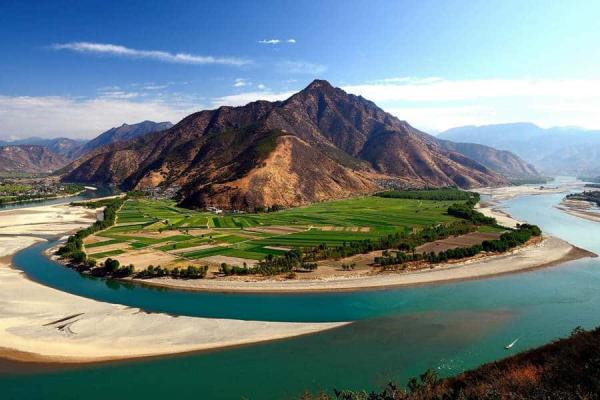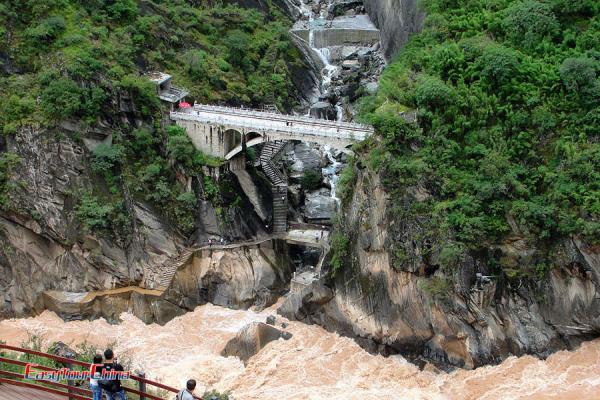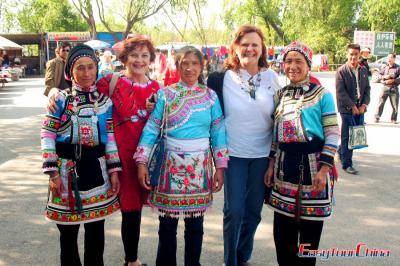Three Parallel Rivers of Yunnan Protected Areas
Three Parallel Rivers of Yunnan Protected Areas refers to the place that Yangtze River (Jinsha River), Mekong (Lancang River) and Salween (Nu River) run parallel from north to south for more than 170 kilometers in Yunnan Province. This region spans 9 nature reserves and 10 scenic spots in Lijiang City, Diqing Tibetan Autononous Prefecture and Nujiang Lisu Autonomous Prefecture of Yunnan Province. In July 2003, UNESCO inscribed the Three Parallel Rivers area on the World Natural Heritage List.
The Three Parallel Rivers of Yunnan Protected Areas region is known as the "world biological gene bank". It only accounts for less than 0.4% of China's land area, but it has more than 20% of China's higher plants and 25% of China's animal species. There are 77 national protected animals, such as Yunnan snub nosed monkey, antelope, snow leopard, Bengal tiger, black necked Crane and so on.
Jinsha River is the upper reaches of the Yangtze River, and it finally flows into the East China Sea; Lancang River is the upper reaches of the Mekong River and finally flows into the South China Sea; The Nu River is the upper reaches of the Salween River and finally flows into the Andaman Sea. Lancang River and Nu River are international rivers, especially the Lancang River, which is known as "Oriental Danube River" because it flows through six countries (China, Myanmar, Laos, Thailand, Cambodia and Vietnam).

Three Parallel Rivers of Yunnan Protected Areas Facts
-Chinese name: 云南三江并流保护区
-Location: northwest Yunnan Province in southern China, between Myanmar and Lijiang
-Time needed: 1-3 days
-Altitude: from 760 meters to 6,740 meters, there are 118 peaks over 5,000 meters
What to See at Three Parallel Rivers of Yunnan Protected Areas
Three Parallel Rivers of Yunnan Protected Areas are the largest world heritage sites in China. There are 3 scenic areas of Nujiang River, Lancang River and Jinsha River, 8 central scenic areas and more than 60 scenic spots, with a total area of more than 3500 square kilometers. The three parallel rivers pregnant with thousands of years of “riverside culture”.
Here, you will see the unique “Three Rivers” parallel flow, majestic mountains and snow peaks, perilous canyons and shoals, beautiful forest and snow plains, quite glacial lakes and flower meadows, unique ethnic customs, etc.

Major Attractions at Three Parallel Rivers of Yunnan Protected Areas
The First Bend of Yangtze Riiver
As the longest river in China, the Yangtze River, runs from the roof of the world, the- Qinghai-Tibet Plateau, and then into Yunnan Province, converging with the Lancang River and the Nu River in the mountain ranges. The First Bend of Yangtze Riveris the Jinshajiang section of the Yangtze River, with an elevation of over 1800 meters. It is located in the Stone Drum Town of the Yulong Naxi Autonomous County, Lijiang City, and 130 kilometers away from Shangri La County. This attraction is a scenic and hiking area which is situated 1,850 meters above sea level.
Tiger Leaping Gorge
Tiger Leaping Gorge is a canyon on the upper reach of the Yangtze River, which part is usually called Jinsha River (Golden Sand River). The gorge is located where the river passes between 5,596-meter-high Jade Dragon Snow Mountain and 5,396-meter-high Haba Snow Mountain in a series of rapids under lofty 2000-metee-deep cliffs. The narrowest part of the gorge is the Tiger Leaping Gorge, which is regarded as the home to China’s best hiking trail.
Meili Snow Mountains
The Meili Snow Mountains lie on the border of Tibet and Yunnan, it is considered as one of the four great holy mountains for Tibetan Buddhists. Meili Snow Mountain is also known as the prince of snow mountain. There are 13 peaks with an average altitude of more than 6000 meters, which are called "Prince 13 peaks". The main peak, Kawagebo peak, is 6740 meters above sea level, the highest peak in Yunnan. Due to the unique terrain and climate factors, no one has successfully reached the summit. Meili Snow Mountain area has the typical geomorphic features of Lancang River Basin and is the original habitat of Yunnan snub nosed monkey. Yubeng Village is located right at the foot of the mighty Meili Snow Mountains with only 20 or so households and known among the outdoor enthusiasts as one of the best treks in China. Yubeng is almost inaccessible from the outside world, riding a horse and hiking for a day was previously the only two ways to get to Yubeng Village.
Haba Snow Mountain
Haba Snow Mountain is located in the southeast of Shangri La County, the main peak is 5396 meters above sea level. Haba Snow Mountain is one of the high mountains in Yunnan Province and it is also the southernmost marine temperate glacier in China. Haba in Naxi language means “golden flower”. The climbing season of Haba Snow Mountain is from November to February of the next year. Affected by the monsoon, the wind is strong in January and February, often reaching above level 8. The wind is less strong in November and December, which are regarded the best seasons for climbing.
Laojun Mountian
As one of the main scenic spots of the three parallel rivers, it is the watershed of the three rivers. The main peak is 4,247 meters above sea level, covering an area of more than 710 square kilometers. It mainly includes 99 Longtan area, Jinsishi Jinshan Yuhu area, Lizeng Yunnan snub nosed monkey nature reserve, Liming/Meile Danxia landform area, etc.


